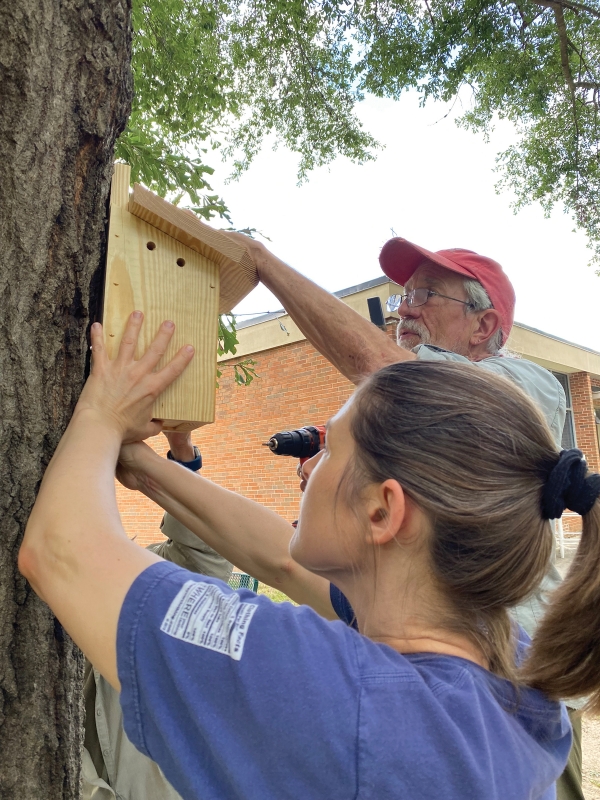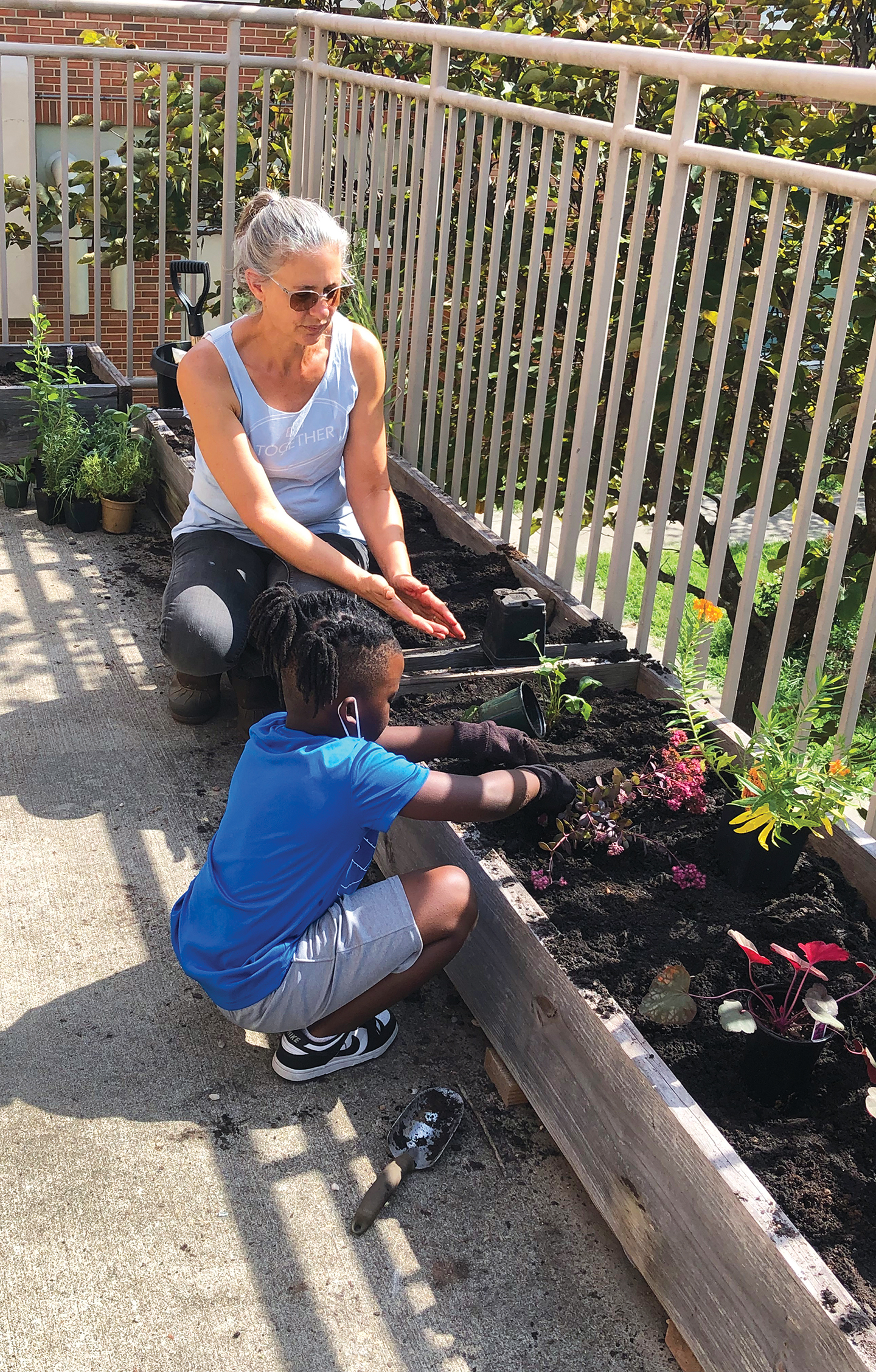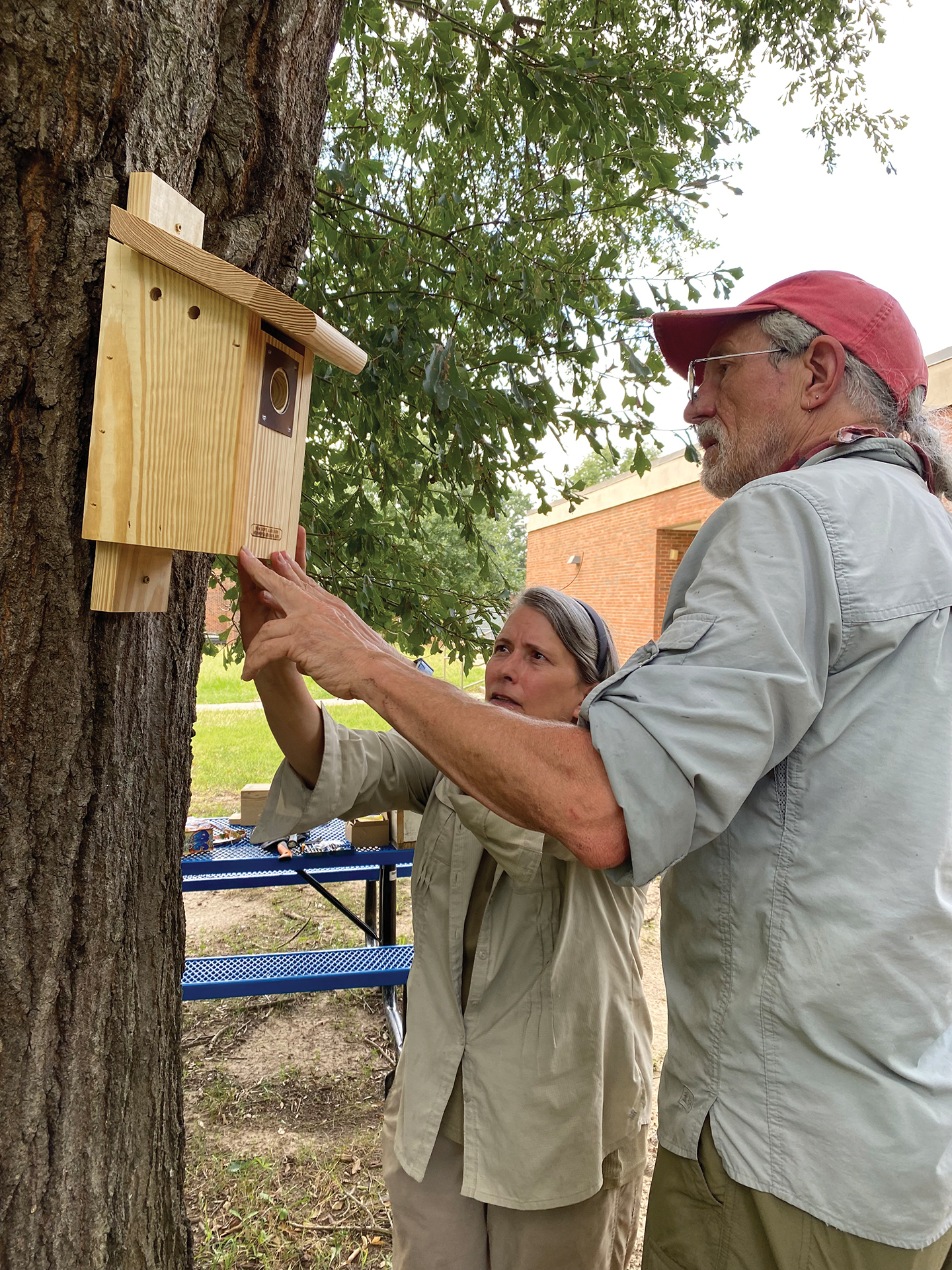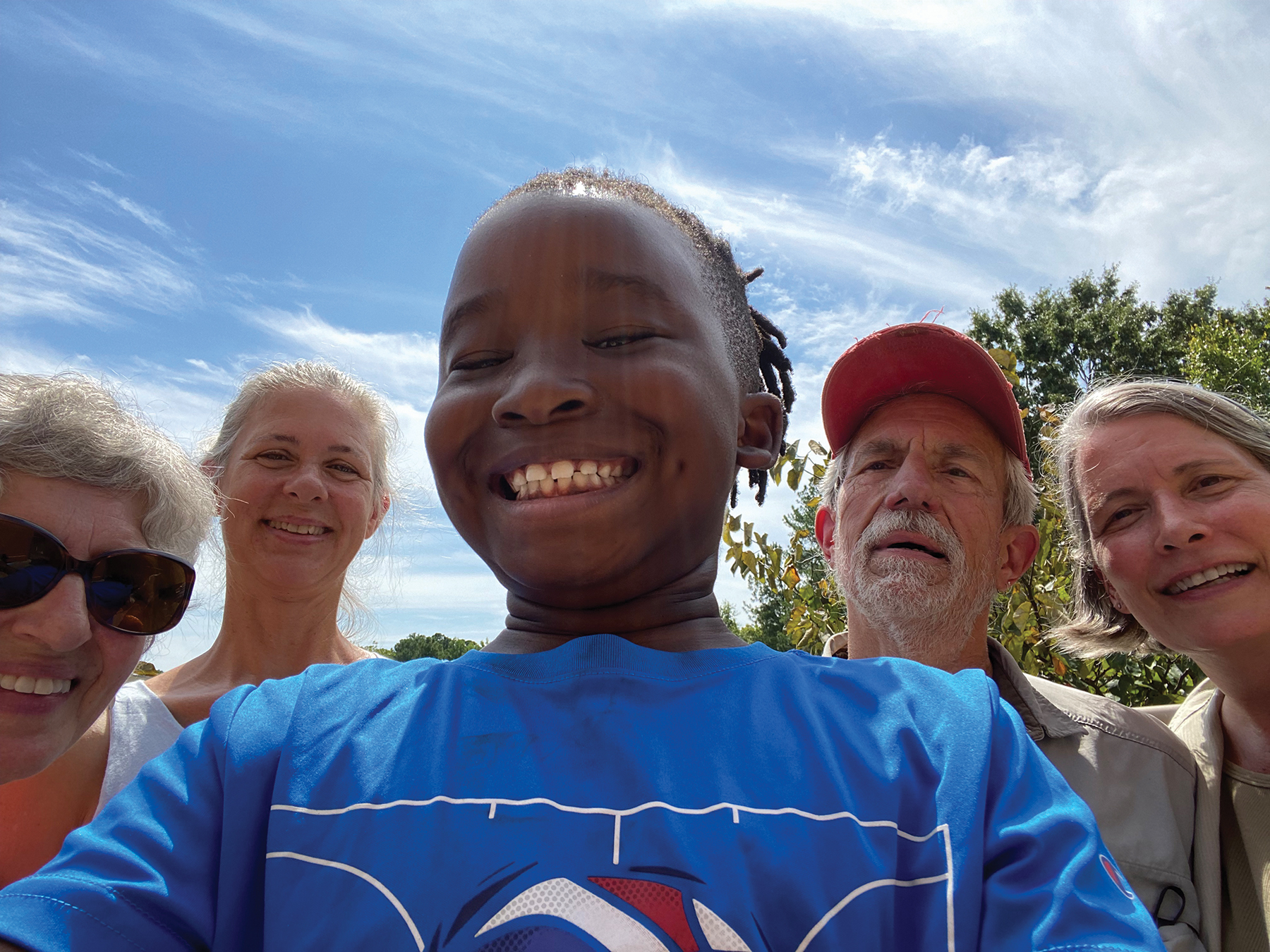Disciple: The Outdoor Learning Project

A partnership with schools brings Creation Care to students
By Christine McTaggart
Some great ideas come into being in a single revelation. Others come together piece by piece, as one thought leads to another until those pieces merge to form a picture of what’s possible.
Such was the case with the Outdoor Learning Project, a partnership between St. Titus’ and St. Philip’s, Durham, and Fayetteville Street Elementary School. It began with the Creation Care grants offered by The Episcopal Church. With the grants’ emphasis on environmental projects with a focus on racial equity, the Rev. Jill Staton-Bullard, deacon at St. Philip’s, wondered if it was something the congregation might consider. She discussed it with the Rev. Stephanie Yancy, then-rector of St. Titus’, and Lew Myers, member of St. Titus’, and soon extended the conversation to include Sue Guptill, a member of St. Philip’s and Diocesan Council. Together they thought about the possibilities of creation care offerings. They had a lot of ideas, but over the course of conversations, they realized they didn’t have enough of a model to apply. But the enthusiasm for the possibilities remained, and, before long, the brainstormers included the Rev. Sarah Woodard, deacon at St. Titus’, as well.
[Image: Members of St. Titus’ and St. Philip’s, Durham, create a sensory garden, complete with bird boxes and interesting plants, at Fayetteville Street Elementary School. Photos throughout by Alexa McKerrow]
Around that same time, St. Philip’s had been bequeathed a beautiful property in Durham that came to be known as St. Philip’s in the Trees. With acres of woods and a building on the property, the congregation was in the process of discerning how the site could be shared with the public to become a place of retreat and learning. The idea of a partnership with the Museum of Life and Science was explored, with thoughts coalescing around the idea of bringing students to the site to learn about creation care. A workable and sustainable approach proved elusive at that time, but the idea of working with students took hold. So the question was examined from another angle: If the pieces weren’t yet in place to bring students to a site to learn about creation care, how might creation care be brought to the students?
FINDING THE PARTNER
When discussing possible partnerships for St. Philip’s in the Trees, local schools were receptive to the general idea of connecting students and nature, even if the logistics were proving to be too much. So conversation turned to how St. Philip’s and St. Titus’ might partner with schools in another way.
The first question was which school would be the churches’ pilot partner? Guptill and Myers began exploring possible members of administration to approach with the idea, when a simple Google search revealed a connection that seemed explainable only by the work of the Holy Spirit.
Dr. Linda Turgurian was the Public School STEM and Outdoor Educator for Durham Public Schools. She also happened to be a member of St. Philip’s.
“That was such a blessing,” said Guptill, “because we didn’t have to explain the whole Episcopal Church to her, or the diocese or bishops or what we meant by creation care. She knew us, and she knew St. Titus’. And it turned out her passion was outdoor learning, or what we call creation care.”
The team explained the partner churches’ wish to collaborate with local schools on a creation care project, as well as their thoughts on starting with one of the two elementary schools in the local area. They admitted they weren’t sure where to start in their approach to the schools. Who were the people in the schools actually engaged in this type of learning? What did outdoor learning mean to the schools? Were there curricula already in place? Were there resources needed by the schools the churches could help provide?
Turgurian was a godsend. She helped the team identify Fayetteville Street Elementary School as the best fit for what the church had to offer and what was already happening in the school. Fayetteville Street Elementary had a vision of what they wanted to do, and around that time Alexa McKerrow of St. Philip’s and Mary Beth Berkaley of St. Luke’s, Durham, joined the initiative, bringing with them botanical know-how the team lacked.
“Our goal was to fill in some gaps and to provide some knowledge where we have it,” said Guptill. “We’re happy whenever and wherever we can find ways to fit. We were working to develop a template on how this kind of project might go, always with the thought that at each school, we would adjust the template to fit that school.”
REPLANTING THE GARDEN

At Fayetteville Street Elementary, art teacher Nancy Lambert years before had created a pollinator garden. Untended during the pandemic, there was a wish to renovate and expand it. Eight existing flowerbeds provided the foundation, and the team went to the school to help with the evaluation of what needed to be done to bring them back to life.
At the same time, another partner with whom the school had worked, Creekside Cares, was brought into the conversation. Creekside Cares is a community service organization whose mission is to support and advance educational opportunities in their local area. They were longtime partners of Durham Public Schools, and the team met with them to see what resources they might bring to the renovation project.
It turned out they brought quite a bit, especially in the form of tools and knowledge. With the churches purchasing needed supplies and the know-how of Creekside Cares, the flowerbeds were renovated over the summer and readied for an August planting and the start of the school year.
As the renovations were happening, Lambert and several other teachers met with staff at the Museum of Life and Science to develop ideas around outdoor education. In the course of those conversations, it was decided to use the flowerbeds under renovation to create not just a renewed pollinator garden, but a full sensory garden. In such a garden, carefully selected plants provide the space with a multitude of colors, smells and tactile experiences for the students to enjoy. As the garden is established, the experience can be enhanced in other ways, with visuals like painted rocks and auditory additions like wind chimes. The team consulted with the Audubon Society to learn about identifying optimal locations for bird houses and bird baths, bringing yet another natural element to the sensory garden.
“Once the ball was rolling,” said Guptill, “it was possible to gather in more people. That’s something I think could happen at any school. Who are they already partnering with, and how can we support that?”
The plan was brought to fruition in the latter part of August. The flowerbeds were planted and the birdhouses installed. Among the plantings were butterfly weed for color; thyme, sage and anise for smell; cone flower and Lamb’s Ears for touch; and switch grass for the rustling sound it makes when the wind blows through it. Catnip and mountain mint provide combined olfactory and tactile sensations, and future hopes for the garden include false indigo, whose seed pods produce a rattle in the breeze, and pig squeak, a well-named, small leaf that squeaks like a pig when rubbed.
It has been a big hit with the students. “The kids are loving it,” said McKerrow. “I was there on a day when a second grade teacher had the kids spend about 30 minutes in the garden, and they were very excited to explore it and spend time in it. The teacher was going to have them go back to class and write about their experience.”
BE THE RESOURCE

The project team at St. Titus’ and St. Philip’s hopes the Fayetteville Street Elementary project is only the first of many outdoor learning collaborations. Already they are considering possible future partners, but they recognize creation care initiatives are not the first priority of every school.
“[For some schools], they’re not ready for it yet,” said Guptill. “They are putting out fires constantly at their school.”
“The fact is, the schools don’t have any resources,” said Myers. “They don’t have time to think about stuff like this. They know what they want to do, but they’re just overworked and under-resourced.”
That’s why the team hopes their experience with Fayetteville Street Elementary can become a template from which they and others can work. It begins with leaders like Lambert and Turgurian, “somebody on the ground who cares,” said Myers. Let those leaders be the voice for what’s needed, and, once that’s known, explore the resources readily available to fulfill those needs. In the case of the Fayetteville Street Elementary sensory garden, the financial cost of the lumber and building accessories was absorbed by the churches, and Creekside Cares brought the volunteers and tools needed to put it all together.
“As we get a little more experience, we’ll know more and more about how to have the conversation to learn what’s needed and how to bring people together to find it,” said Guptill. “As we get more skillful and more adept at that, going into other schools will be easier because we won’t be fumbling around. They don’t need fumblers. They need people who are pretty clear about what can be done and how they might be able to do it.”
Too, as this first experience becomes the foundation for the next, partnerships established may be carried on to future projects, with new collaborations coming in to the mix.
“It’s a matter of making the connections,” said Myers. “We knew some people, and they knew some people, and that’s how this thing can multiply.”
Learning from the project creates enthusiasm for the next project as well, as parishioners and partners gain a greater understanding of how they might contribute. “It creates a confidence for parishioners who are interested in doing this and empowers them to come out,” said Woodard. “Everyone who’s taken part is talking about it, and that’s getting others excited and thinking, ‘Hey, I can do this.’”
The team is glad to be able to support the outdoor learning opportunities schools want to offer. Long-term, Myers hopes the efforts happening now become a standard part of every school’s curriculum. “I think it ought to be ‘institutionalized,’” he said. “Schools ought to have somebody dedicated to this that can go into schools and do assessments to know who’s ready for outdoor learning. It needs to be funded.”
He recognizes there may be a few steps needed before that happens. “I think we need to have a study done,” he said. “Maybe a student could do it for academic credit. But we can advocate for that, and then advocate for the funding and resources the study identifies.”
In the meantime, Myers says, “We can have an impact. We’re committed. We started with nothing and put this [first] thing together. We made a difference in one school, we can do it in two, we can do it in more than that. That’s what the Church can do, because we have the folks who know how to do it.”
For those who might be interested in creation care partnerships with their own local schools, the outdoor learning team advises partnering with a school that already has a clear vision, even if they don’t have the resources to execute that vision. Not sure who might have those visions? Ask those with whom you are already in relationship. Many churches already work with schools on backpack, food or tutoring programs. Talk with those involved in those projects and ask what outdoor learning hopes the school might have and who might be able to have the conversation about those hopes.

[Image: A volunteer team selfie.]
“There are a lot of partnerships you can be a part of without having to be in charge of everything,” said Guptill. “You can build relationships with various schools and fit in as they need you, rather than you just saying, ‘This is what we’re going to do.’”
As for the St. Philip’s and St. Titus’ team, they remain in partnership with Fayetteville Street Elementary while working to partner with another school and expand what they’re able to offer. “I think we have more resources in our congregations that we haven’t tapped yet,” said Guptill.
One thing is for certain: The team will use their experience from the Outdoor Learning Project as a template and be ready to adapt to what’s needed next, one piece at a time.
Christine McTaggart is the communications director for the Diocese of North Carolina.
Tags: North Carolina Disciple / Creation Care
